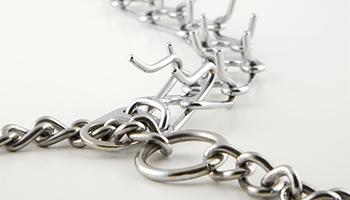Why prong collars are harmful to dogs
Prong collars are painful and unethical training collars. Owners use this on their dogs in an attempt to stop them from pulling on the lead. They can cause serious harm to dogs and are an ineffective training method.
Prong collars can be perceived to be a quick fix to help control dogs. They're often marketed by sellers as safe and quite gentle. Sadly, this isn't the case.
Shock collars are similar but use an electric shock instead of prongs.
What are prong collars and are they cruel?
Prong collars are designed to cause pain or discomfort to the animal to reduce or stop them from pulling on their lead.
They're based on the principle of applying something painful or frightening to stop unwanted behaviour. When a dog pulls on the lead, the metal prongs of the collar close and prong the sensitive skin around the neck. The prongs cause pain as well as potential injury and infection from puncture wounds and nerve damage.
Research has shown that aversive training techniques, like prong collars, can cause pain and distress and can compromise dog welfare. We also know that painful and distressing training techniques have long term effects on the mental wellbeing and overall happiness of dogs.

Do prong collars work?
As well as being painful and distressing, prong collars (and other similar techniques) don't teach positive dog behaviour. In fact, they're likely to cause confusion. The pain a dog feels when wearing one might have them relate it to something else completely.
As an example, if a dog is pinched by the prongs at the same time as being approached by a child, they might link the child with the pain they feel from the prongs. This can then cause the dog to view children as something to be worried about - leading to behaviour problems that didn't exist in the first place.
Prong collars can cause new behaviour problems
Being in pain when walking creates fear, distress and anxiety and those negative feelings can trigger negatively motivated behaviours in dogs with high levels of arousal, including aggression.
Dogs work really hard to please us and to fit in. Whilst excessive lead pulling can be very frustrating to manage, it's important to remember that your dog isn't trying to upset you.
Many won't realise that their dog no longer pulling on the lead may have come at a cost. Owners won't recognise that what's supposed to be a really pleasurable and rewarding experience for the dog can be quite the opposite.
Ethical alternatives to prong collars
Loose lead walking is a skill that takes time, patience and consistency. In the end it's well worth the hard work when you're able to take enjoyable walks with your dog. Spend time training your dog using ethical, reward-based methods. This not only helps them to learn essential life skills, but builds trust and strengthens the bond between you both.
You can safely use a well-fitting and comfortable harness to help control your dog. You can also teach them, using food, to walk nicely by your side.
Learning should be fun for dogs and humans alike. If you find that you're struggling then you could contact one of the many dog trainers across the country. They'll be able to help you and your dog without subjecting them to techniques that can cause pain or fear.
Are prong collars legal in the UK?
Prong collars aren't illegal sadly. Although people sell them state that they're 'quite gentle training tools,' we believe the opposite to be true and we want to see them banned.
Do vets recommend prong collars?
Lorella Notari, our vet clinical head of behaviour and European specialist says:
The repeated pressure of collars like choke and prong collars can cause severe inflammation of the skin and muscle, and in extreme cases can cause cervical spine injuries. These collars can make a dog cough and even cause the windpipe to collapse. It can also injure the thyroid glands.
I've dealt with more than one case where lesions (caused by prong collars) were only discovered when the dogs developed severe infections - ulcers and pus that couldn't be ignored. Sadly, the initial small skin lesions due to the pins' pressure were hidden by the fur and overlooked.
The bottom line is using prong collars in dogs causes physical and mental suffering. As a vet, I'd never recommend their use for training.
Shock collars
Shock collars (also known as electronic training collars or e-collars) are collars that emit an electronic pulse to stop unwanted behaviour. In order for the shock to suppress the unwanted behaviour, it needs to be sufficiently unpleasant to the animal. The electric shock can cause physical problems. It can also cause behaviour issues linked with pain, fear and stress.
How they work
- They deliver an electrical stimulus on demand by remote control in order to suppress unwanted behaviour
- They can deliver an electric shock to an animal's neck up to a radius of two miles. This means an animal not within sight of its owner could still be shocked
- Electric shocks can last up to 11 seconds at a time
- E-collars can worsen underlying behavioural problems, cause new behaviours to arise and cause anxiety and aggressive behaviour
Using these collars could lead to abusing its use. The only people who stand to benefit from e-collars are those who profit from them. It's also difficult to predict the level of shock needed for a dog, as the severity will be affected by:
- Temperament
- Previous experiences
- Amount used
- Where on the neck it shocks
- Thickness of hair
- Level of moisture on the skin
Shock collars are still legal in parts of the UK
Shock collars have been illegal to use on dogs and cats in Wales for more than a decade. This isn't the case in England, where they're legally allowed to be used without restriction. The UK Government announced in 2018 that they were planning to ban the use (but not sale) of shock collars in England.
Ban shock collars in England
There's a risk that the UK Government will backtrack on their plans to ban shock collars. We have until 4 September 2023 to encourage our MPs to keep their promise. Join our campaign to bring England in line with Welsh legislation.


